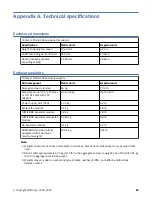
Preventing electrostatic discharge
To prevent electrostatic discharge (ESD) from damaging the system, be aware of the precautions to
consider when setting up the system or handling parts.
A discharge of static electricity from a finger or other conductor may damage system boards or other
static-sensitive devices. This type of damage may reduce the life expectancy of the device.
CAUTION: Parts can be damaged by electrostatic discharge. Follow these precautions:
• Avoid hand contact by transporting and storing products in static-safe containers.
• Keep electrostatic-sensitive parts in their containers until they arrive at static-protected
workstations.
• Place parts in a static-protected area before removing them from their containers.
• Avoid touching pins, leads, or circuitry.
• Always be properly grounded when touching a static-sensitive component or assembly.
• Remove clutter (plastic, vinyl, foam) from the static-protected workstation.
Grounding methods to prevent electrostatic discharge
Several methods are used for grounding. Adhere to the following precautions when handling or installing
electrostatic-sensitive parts.
CAUTION: Parts can be damaged by electrostatic discharge. Use proper anti-static protection:
• Keep the replacement CRU in the ESD bag until needed; and when removing a CRU from the
enclosure, immediately place it in the ESD bag and anti-static packaging.
• Wear an ESD wrist strap connected by a ground cord to a grounded workstation or unpainted
surface of the computer chassis. Wrist straps are flexible straps with a minimum of 1megohm (±
10percent) resistance in the ground cords. To provide proper ground, wear the strap snug
against the skin.
• If an ESD wrist strap is unavailable, touch an unpainted surface of the chassis before handling
the component.
• Use heel straps, toe straps, or boot straps at standing workstations. Wear the straps on both feet
when standing on conductive floors or dissipating floor mats.
• Use conductive field service tools.
• Use a portable field service kit with a folding static-dissipating work mat.
If you do not have any of the suggested equipment for proper grounding, have an authorized technician
install the part. For more information about static electricity or assistance with product installation,
contact technical support.
Replacing a PSU module
This section provides procedures for replacing a failed power supply unit (PSU) module.
Illustrations in PSU replacement procedures show rear panel views of the enclosure, with the PSU
properly oriented for insertion into the rear panel of the enclosure.
A single PSU is sufficient to maintain operation of the enclosure. You need not halt operations and
completely power-off the enclosure when replacing only one PSU; however, a complete orderly shutdown
is required if replacing both units simultaneously.
CAUTION: Do not remove the cover from the PSU due to danger from electric shock inside. Return
the PSU to your supplier for repair.
See CAUTION bullets regarding electrostatic discharge and anti-static protection.
Tip: The illustrations show PSU module replacement as you face the enclosure rear panel. See also Figure
4 on page 10 and Figure 7 on page 11.
68 IBM ESS expansion: Hardware Installation and Maintenance Guide - Model 106
Summary of Contents for 106
Page 6: ...Russia Electromagnetic Interference Class A Statement 100 Homologation statement 100 vi...
Page 12: ...xii...
Page 18: ...xviii IBM ESS expansion Hardware Installation and Maintenance Guide Model 106...
Page 20: ...2 IBM ESS expansion Hardware Installation and Maintenance Guide Model 106...
Page 44: ...26 IBM ESS expansion Hardware Installation and Maintenance Guide Model 106...
Page 84: ...66 IBM ESS expansion Hardware Installation and Maintenance Guide Model 106...
Page 100: ...82 IBM ESS expansion Hardware Installation and Maintenance Guide Model 106...
Page 108: ...90 IBM ESS expansion Hardware Installation and Maintenance Guide Model 106...
Page 119: ......
Page 120: ...IBM SC27921101...
















































